A detailed look at some of my favorite N64 racing games.
Mario Kart 64 was one of the biggest games to hit the Nintendo 64. For the first time ever, up to four players could race each other at the same time thanks to the N64’s four controller ports. The game was also Mario Kart’s first foray into fully 3D environments, allowing for more creative track designs than ever before. It was the step up from Super Mario Kart everyone wanted, and it delivered masterfully. I remember playing for hours on end with my brother, and to this day, it remains one of my favorite Nintendo 64 games to revisit.
Aside from Mario Kart, another game on the Nintendo 64 frequently comes up whenever the discussion of kart racers comes up, and that is Rareware’s Diddy Kong Racing. Unfortunately, I did not own Diddy Kong Racing; instead, my parents bought me Rareware’s other racing game, Mickey’s Speedway USA. A sequel to Mickey’s Racing Adventure on the Game Boy Color, Mickey’s Speedway followed Mickey Mouse and his friends as they race through many famous American locales as San Francisco and the Grand Canyon.
In many ways, Mario Kart 64 and Mickey’s Speedway are similar. Each has Grand Prix, Versus, Time Trials, and Battle/Contest modes. They all feature a wide variety of tracks, items, and obstacles, as well as an assortment of different characters. Both games feature multiplayer modes as well, making them ideal for party play. That is not to say that the two games are not without their differences, though. I will touch on all of these aspects one by one below.
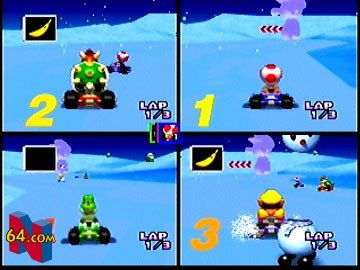
Let us first talk about the story. In Mario Kart, there is no story, but in Mickey’s Speedway, someone out there decided to put in something so nonsensical that it almost feels like satire. Apparently, Pluto has been kidnapped by the Weasels, and Mickey and his friends have to race each other across the country to save him – despite the fact that racing in loops and throwing items at each other is counterintuitive to their mission. Moreover, Pete is a playable character in the game, and considering that he is one of Mickey Mouse’s main villains, you really have to start to wonder if any of this even makes any sense.
Speaking of playable characters, each game has a wide variety of different racers to select. The characters in Mario Kart 64 are classified by tiers, with heavy characters having high top speed but slow acceleration, and light characters having low top speed by high acceleration (also, heavy characters could crash into light characters and spin them out!). The characters in Mickey’s Speedway are also tiered, but with a little bit more variety, as well as extra, unlockable characters/tiers, one of which is practically unplayable (Ludwig, why do you have terrible turning/acceleration but a ridiculously high top speed?!).
There is one other aspect about Mickey’s Speedway’s characters that I want to talk a bit more about, and that is that they are extremely chatty. Literally every time a character does something (crosses the starting line, hits another racer with an item, gets hit by an item, passes another racer, gets passed by another racer, hits a wall, gets a speed boost, or makes a jump), he or she makes some sort of comment either at the other racers or to themselves. It becomes so ridiculous that the game cannot keep up with all the chatter and will cut off other characters just to make for lost time. As absurd as it sounds, I absolutely love it, as it gives Mickey’s Speedway racer this sense of vitality that takes advantage of the trademark Disney characters we love.
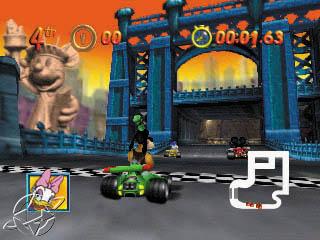
Obviously, we cannot talk racing games with talking tracks. Mario Kart 64 features four cups of four tracks each, each of which have unique obstacles. Kalimari Desert, for example, features a large train that intersects with the track at several points. Toad’s Turnpike takes place on a freeway with large cars and trucks as hazards. Sometimes, the tracks have no obstacles at all, but instead utilize track features to stand out. Wario’s Stadium features huge jumps and bumps, and is among one of my favorite kart-racing tracks of all time. Yoshi Valley has multiple routes for you to explore, complete with huge cliffs that take forever to reach the bottom, shaving precious time off the clock for anyone unfortunate enough to fall off.
Mickey’s Speedway offers five cups of four tracks each, the last of which is ridiculously difficult. It is immediately obvious that the game is much more strategic than Mario Kart because of not only the added difficulty, but also the fact that most tracks have some sort of built-in shortcut to them. A lot of these shortcuts are difficult to find, and even harder to execute. The game punishes those who enter these shortcuts unprepared, which adds a much larger element of skill required to be successful in this game. Unfortunately, I feel that Mickey’s Speedway’s tracks are less memorable, mostly because obstacles are rare, and the tracks do not have that many distinguishing features among them.
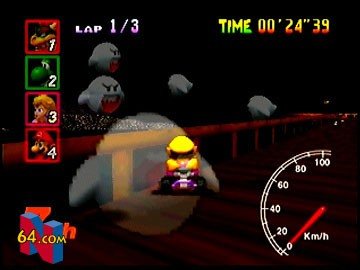
Let us talk a bit more about strategy. Both games feature a wide assortment of items, which are interestingly similar to each other. Here is the rundown for you to see what I mean:
- The banana peel in Mario Kart can be either left behind you or thrown ahead of you. Racers who step on the banana peel spin out. The “Paint Spo-Cha” (what?) in Mickey’s Speedway does the same exact thing.
- The green shell in Mario Kart can be shot ahead or behind you, and they bounce off wall until they hit an opponent. The “Baseball Chucker” in Mickey’s Speedway does the same exact thing, except after a few bounces, the baseball ultimately stops moving.
- The red shell in Mario Kart follows the track and hits whoever is in front of you. The Magno Flyer in Mickey’s Speedway does the same exact thing.
- The mushroom in Mario Kart gives you a temporary speed boost. The “Sprinter” in Mickey’s Speedway does the same exact thing.
- The star in Mario Kart makes you invincible, impenetrable to hazards/items, and knocks any character you hit out of the way. The “Shield Shell” in Mickey’s Speedway does the same exact thing.
- The lighting bolt in Mario Kart shrinks every other racer, slows them down, and makes them vulnerable to the one who used it. The “Stormy Weather” (seriously, they did not even try) in Mickey’s Speedway USA does the same exact thing.
To be fair, Mickey’s Speedway USA also has its own set of unique items. This includes the Token (which increases the racer’s maximum speed – another aspect stolen from Super Mario Kart), the Trace Chaser (which acts like a Red Shell, but does not follow the track), and – oh wait, that is it. Mario Kart 64, on the other hand, also features a fake item block, triple shells, quintuple bananas, a golden mushroom, a boo item, and the dreaded blue shell. Interestingly, in Mario Kart 64, the computer-controlled characters can only use bananas, stars, mushrooms, boos, and the lightning bolt, whereas the all the characters in Mickey’s Speedway are able to use all the items.
Both games also feature drifting, though each uses the feature a bit differently. In Mario Kart 64, drifting allows you to build up a temporary speed boost that activates immediately after the turn. In Mickey’s Speedway, drifting is the only way to turn without losing any speed, and thus a necessary skill for the higher difficulties.
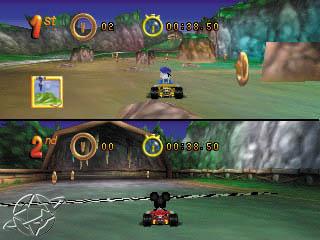
In addition to racing, both games feature a time trials mode and an arena-type multiplayer mode. In time trials, both games allow you to select any track and race against both user and staff records. Battle/Contest Mode also works similarly in both games; players get to race around an arena and shoot items at each other, and whoever loses all three of their lives loses. The only difference between Battle Mode in Mario Kart and Contest in Mickey’s Speedway is that Mickey’s Speedway allows you to play against the computer.
Speaking of multiplayer – my goodness are these games so much fun to play with friends. The Nintendo 64’s four controller ports allowed for the first time four-player simultaneous play, creating brand new and unique experiences no one will ever forget. In Battle/Contest Mode, four players meant constant chaos and confusion, ingredients for having some of the most fun you can possibly have in a video game. Seriously, if there was any genre best-suited for this type of play, it was kart racing, and Mario Kart 64 and Mickey’s Speedway USA represented some of the best.
Some differences in presentation is pretty apparent between the two games. In terms of visuals, Mario Kart 64 looks pretty atrocious since a lot of the game is made up of sprites and low-resolution textures. This is less so with Mickey’s Speedway, which also features some cool ambience particle effects. The music in both games are great, though ultimately I found Mario Kart’s soundtrack catchier and more memorable.
So, you may be wondering, with all this comparing and contrasting, which game is better: Mario Kart 64 or Mickey’s Speedway USA? Honestly, I love both, but if I were to choose one over the other, it just has to be Mario Kart. Perhaps it may not be the better game in terms of presentation, but there was nothing like it at its time, and I had an absolute blast. Mickey’s Speedway is still a great game, but in the end, I do not have as strong a nostalgia for it as I do with Mario Kart. I guess that is just what happens when you grow up in the house that Mario built.
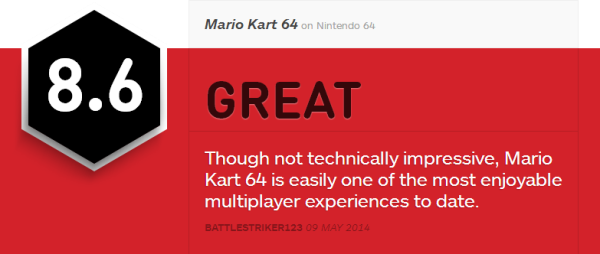
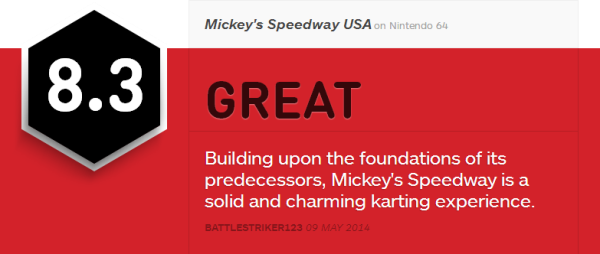
Did you play Mario Kart 64 or Mickey’s Speedway USA? Which kart racing games did you enjoy as a kid? Discuss in the comments below!
Mario Mario Kart Month:
![Amazing Spider-Man Finale Features New [SPOILER] Costume](../../../../../../assets1.ignimgs.com/2018/06/01/untitled-br-1527892808294_small.jpg)